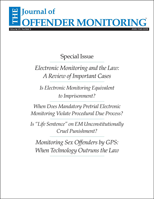Electronic Monitoring in Florida
Author: William Bales.; Karen Mann.; Thomas Blomberg.; Brian McManus.; Karla Dhungana.
Source: Volume 22, Number 02, Fall/Winter 2009 , pp.5-12(8)

next article > |return to table of contents
Abstract:
Earlier this year, a team of researchers at Florida State University submitted a report entitled “A Quantitative and Qualitative Assessment of Electronic Monitoring” to the U.S. Department of Justice. The research team studied the use of RF and GPS systems as used by the Florida Department of Corrections, and while the report has not yet been published by the DOJ, it is something, the authors feel, the field has needed for a very long time: a rigorous examination of the evidence on electronic monitoring and its relative effectiveness in achieving various criminal justice policy goals. One of the most valuable elements of the report is a section devoted to describing, in very comprehensive detail, how electronic monitoring is used in Florida. Florida has been one of the leading states in the adoption and deployment of electronic monitoring, and the report’s summary of the governing legislation, departmental policies and procedures, caseloads, technology utilization, and most importantly, outcomes, serves as a very useful example of a successful electronic monitoring program. Key exhibits include “Number of offenders placed on electronic monitoring in Florida: FY2000-01 to FY2008-09”,“Number of offenders placed on electronic monitoring in Florida by type of EM device: FY2000-01 to FY2008-09”, “Number of offenders on electronic monitoring in Florida on June 30th: FY2000-01 to FY2008-09.”Keywords: community supervision; sex offender residency restrictions
Affiliations:
1: Florida State University; 2: Florida State University; 3: Florida State University; 4: Florida State University; 5: Florida State University.